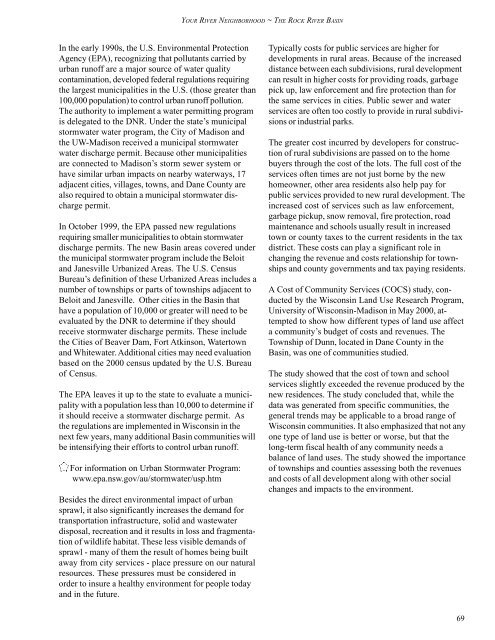Cities (PDF, 295KB) - Wisconsin Department of Natural Resources
Cities (PDF, 295KB) - Wisconsin Department of Natural Resources
Cities (PDF, 295KB) - Wisconsin Department of Natural Resources
Create successful ePaper yourself
Turn your PDF publications into a flip-book with our unique Google optimized e-Paper software.
YOUR RIVER NEIGHBORHOOD ~ THE ROCK RIVER BASIN<br />
In the early 1990s, the U.S. Environmental Protection<br />
Agency (EPA), recognizing that pollutants carried by<br />
urban run<strong>of</strong>f are a major source <strong>of</strong> water quality<br />
contamination, developed federal regulations requiring<br />
the largest municipalities in the U.S. (those greater than<br />
100,000 population) to control urban run<strong>of</strong>f pollution.<br />
The authority to implement a water permitting program<br />
is delegated to the DNR. Under the state’s municipal<br />
stormwater water program, the City <strong>of</strong> Madison and<br />
the UW-Madison received a municipal stormwater<br />
water discharge permit. Because other municipalities<br />
are connected to Madison’s storm sewer system or<br />
have similar urban impacts on nearby waterways, 17<br />
adjacent cities, villages, towns, and Dane County are<br />
also required to obtain a municipal stormwater discharge<br />
permit.<br />
In October 1999, the EPA passed new regulations<br />
requiring smaller municipalities to obtain stormwater<br />
discharge permits. The new Basin areas covered under<br />
the municipal stormwater program include the Beloit<br />
and Janesville Urbanized Areas. The U.S. Census<br />
Bureau’s definition <strong>of</strong> these Urbanized Areas includes a<br />
number <strong>of</strong> townships or parts <strong>of</strong> townships adjacent to<br />
Beloit and Janesville. Other cities in the Basin that<br />
have a population <strong>of</strong> 10,000 or greater will need to be<br />
evaluated by the DNR to determine if they should<br />
receive stormwater discharge permits. These include<br />
the <strong>Cities</strong> <strong>of</strong> Beaver Dam, Fort Atkinson, Watertown<br />
and Whitewater. Additional cities may need evaluation<br />
based on the 2000 census updated by the U.S. Bureau<br />
<strong>of</strong> Census.<br />
The EPA leaves it up to the state to evaluate a municipality<br />
with a population less than 10,000 to determine if<br />
it should receive a stormwater discharge permit. As<br />
the regulations are implemented in <strong>Wisconsin</strong> in the<br />
next few years, many additional Basin communities will<br />
be intensifying their efforts to control urban run<strong>of</strong>f.<br />
For information on Urban Stormwater Program:<br />
www.epa.nsw.gov/au/stormwater/usp.htm<br />
Besides the direct environmental impact <strong>of</strong> urban<br />
sprawl, it also significantly increases the demand for<br />
transportation infrastructure, solid and wastewater<br />
disposal, recreation and it results in loss and fragmentation<br />
<strong>of</strong> wildlife habitat. These less visible demands <strong>of</strong><br />
sprawl - many <strong>of</strong> them the result <strong>of</strong> homes being built<br />
away from city services - place pressure on our natural<br />
resources. These pressures must be considered in<br />
order to insure a healthy environment for people today<br />
and in the future.<br />
Typically costs for public services are higher for<br />
developments in rural areas. Because <strong>of</strong> the increased<br />
distance between each subdivisions, rural development<br />
can result in higher costs for providing roads, garbage<br />
pick up, law enforcement and fire protection than for<br />
the same services in cities. Public sewer and water<br />
services are <strong>of</strong>ten too costly to provide in rural subdivisions<br />
or industrial parks.<br />
The greater cost incurred by developers for construction<br />
<strong>of</strong> rural subdivisions are passed on to the home<br />
buyers through the cost <strong>of</strong> the lots. The full cost <strong>of</strong> the<br />
services <strong>of</strong>ten times are not just borne by the new<br />
homeowner, other area residents also help pay for<br />
public services provided to new rural development. The<br />
increased cost <strong>of</strong> services such as law enforcement,<br />
garbage pickup, snow removal, fire protection, road<br />
maintenance and schools usually result in increased<br />
town or county taxes to the current residents in the tax<br />
district. These costs can play a significant role in<br />
changing the revenue and costs relationship for townships<br />
and county governments and tax paying residents.<br />
A Cost <strong>of</strong> Community Services (COCS) study, conducted<br />
by the <strong>Wisconsin</strong> Land Use Research Program,<br />
University <strong>of</strong> <strong>Wisconsin</strong>-Madison in May 2000, attempted<br />
to show how different types <strong>of</strong> land use affect<br />
a community’s budget <strong>of</strong> costs and revenues. The<br />
Township <strong>of</strong> Dunn, located in Dane County in the<br />
Basin, was one <strong>of</strong> communities studied.<br />
The study showed that the cost <strong>of</strong> town and school<br />
services slightly exceeded the revenue produced by the<br />
new residences. The study concluded that, while the<br />
data was generated from specific communities, the<br />
general trends may be applicable to a broad range <strong>of</strong><br />
<strong>Wisconsin</strong> communities. It also emphasized that not any<br />
one type <strong>of</strong> land use is better or worse, but that the<br />
long-term fiscal health <strong>of</strong> any community needs a<br />
balance <strong>of</strong> land uses. The study showed the importance<br />
<strong>of</strong> townships and counties assessing both the revenues<br />
and costs <strong>of</strong> all development along with other social<br />
changes and impacts to the environment.<br />
69



![Nature program winter schedule [PDF] - Wisconsin DNR](https://img.yumpu.com/22471254/1/190x245/nature-program-winter-schedule-pdf-wisconsin-dnr.jpg?quality=85)
![City of Middleton [PDF] - Wisconsin Department of Natural Resources](https://img.yumpu.com/22300392/1/190x245/city-of-middleton-pdf-wisconsin-department-of-natural-resources.jpg?quality=85)

![Wetland Conservation Activities [PDF] - Wisconsin Department of ...](https://img.yumpu.com/21975633/1/190x245/wetland-conservation-activities-pdf-wisconsin-department-of-.jpg?quality=85)




![Baraboo River Region[PDF] - Wisconsin Department of Natural ...](https://img.yumpu.com/21975619/1/190x245/baraboo-river-regionpdf-wisconsin-department-of-natural-.jpg?quality=85)




